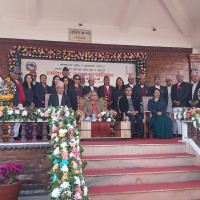- Thursday, 18 December 2025
Toward Sustainable Hydraulic Structures
Rivers are the backbone of human civilisation, a great water source without which today’s development wouldn’t be possible. The natural flow of water under gravity has made it possible to utilise it for multipurpose applications, such as power generation, irrigation, water supply, navigation and recreation. To harness these benefits, it is essential to construct various types of hydraulic structures across the river, such as dams, barrages, weirs, siphons, aqueducts, etc.
Additionally, a large number of river crossing structures, such as roads and railway bridges, are required. For these structures to remain stable on the channel bed, they must be capable of facing flow-induced forces, local morphological changes and various stresses. Thus, for a robust and efficient design of these structures, a time series flow, water level, morphological changes and other necessary data are required. Engineers in developed countries have been collecting both flow data and observations of morphological changes around prototype structures for over a century.
Advancements
The advancements in river science and advanced hydraulics have revolutionised engineers’ ability to measure and analyse flow parameters and channel morphology more rationally. Rivers such as the Mississippi, Nile, Ganges, Rhine, Colorado and Yangtze flowing across different regions of the world have been central to studies. These rivers served as natural laboratories for understanding sediment transport, morphological evolution and related processes. Most of these studies have been done by hydraulic laboratories located at these strategic river banks dedicated especially to studies on river science and applied hydraulics. These locations provide direct, real-time access to flowing water systems, making it possible to conduct realistic experiments, long-term monitoring and full-scale hydraulic testing.
One prominent example is the Utah Water Research Laboratory in the United States, known for applied water research and hydraulic modelling. It is well-equipped with state-of-the-art instruments to collect comprehensive hydrological, water quality, and morphological data. The US and many other nations host numerous such laboratories dedicated to applied research in water resources. Additionally, physical hydraulic model studies, along with field investigations, help analyse complex flow problems at hydraulic structures that may not be accurately predicted using theoretical knowledge alone. The accuracy and efficiency of hydraulic structure design heavily depend on the precision of the collected data, leading to more economical and reliable infrastructure.
For example, Lacey's and Kennedy's regime equations, developed over a century ago based on prototype data from Indian canals on the Indo-Gangetic plains, remain relevant for studying channel regime and bridge scour estimation. Similarly, Melville (1997) & HEC-18 guidelines of the Federal Highway Administration of the US developed a scour depth estimation equation from extensive field and laboratory data across rivers worldwide. These empirical equations remain widely used due to their simplicity and grounding in real-world measurements.
The advancements in hydraulic instrumentation have also enabled a better understanding of air-water interaction challenges. These include studying nappe aeration, cavitation mitigation, and air entrainment in energy dissipation structures like stilling basins, stepped spillways and other appurtenances. Unfortunately, developing countries like Nepal face significant challenges with reliable and accurate data collection. The limited funds and a lack of institutional confidence hinder the carrying out of these activities, crucial for region-specific design. Consequently, designers often adopt a higher factor of safety, leading to larger and more costly structural components.
Nepali rivers traverse five distinct physiographic regions: the high Himalayas, high mountains, middle mountains, Chure (Sivalik), and Tarai plains. These rivers exhibit drastic changes in slope and sediment transport capacity when they pass through the Chure region to the Tarai plains. Most of the sediment tends to accumulate in this region due to reduced transport capacity, while some stretches of the Tarai plains bordering India and extending into the Indo-Gangetic plains often experience sediment deficits, resulting in both local and widespread bed and bank erosion.
Furthermore, the lack of research-based practices for sand and gravel mining in these regions has significantly modified the natural flow and morphological characteristics of various river systems. Therefore, relying on existing equations obtained for other regions may not be equally applicable to Nepal. Thus, data availability for Nepali rivers becomes crucial for the sustainable and robust design of hydraulic structures. These challenges can be addressed by designating one or two representative rivers that flow through all physiographic regions as experimental channels for research and monitoring during the initial stage of the study.
In addition to flow data, the measurement of sediment transport, bed-level changes and other parameters influencing the stability of hydraulic structures should also be initiated. Installing sensors such as sonar-based scour monitors on bridge piers or weirs can provide real-time data on bed-level changes. This technology is relatively low-cost and easy to implement. Selecting a few strategic sites on these rivers would allow systematic monitoring of region-specific morphological changes. These time series data would be useful for developing region-specific equations, refining current empirical models and validating design estimates.
Rivers as experimental channels
The pilot project could be gradually expanded by including some other rivers having different physiographic natures. For hydraulic model studies, a water research laboratory can be set up at one of these designated rivers and can be expanded further based on needs. The lack of long-term hydraulic and morphological data in Nepal has hampered the development of region-specific and sustainable design methodologies. Thus, the selection of one or two representative rivers as experimental channels for detailed study and long-term data collection is deemed necessary. These channels can be equipped with state-of-the-art instrumentation facilities to serve as the foundation for applied research. This strategy will not only enhance the reliability of engineering design but also research and capacity building in water resources.
(Chaudhary is a Ph.D. student at Utah Water Research Laboratory, Utah State University, USA. Mishra is a Ph.D. student at Water Resource Engineering, IIT (ISM) Dhanbad, India.)














